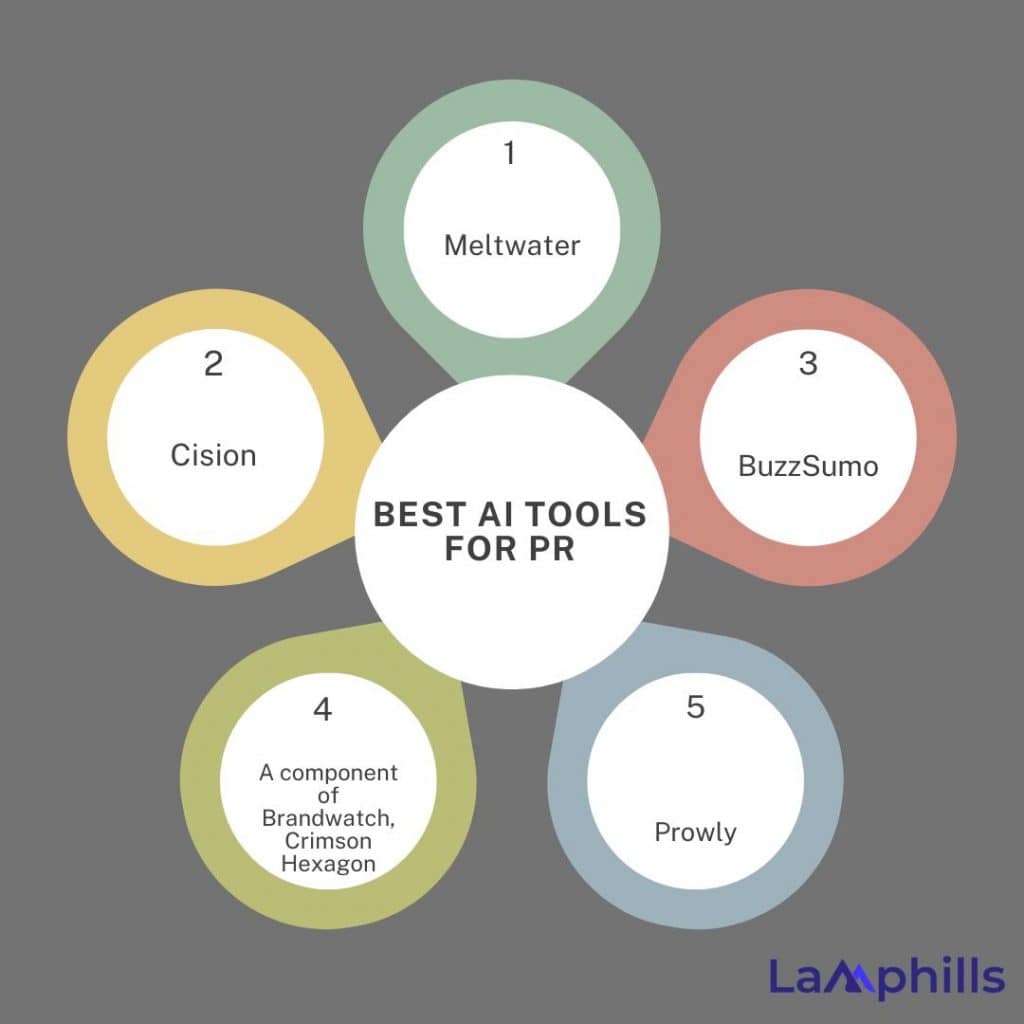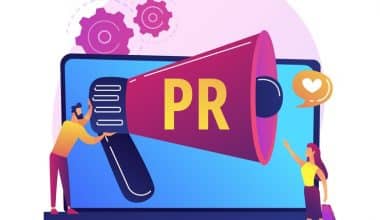Artificial intelligence (AI) has already assumed a variety of roles in public relations (PR) and is still discovering new applications. Since a lot of public relations tasks depend on the internet, AI is an ideal fit because of its speedy analysis of large volumes of data. AI can perform data analysis in seconds that would take a team of humans days to complete, and it can produce more accurate and current insights. Automating manual tasks is another excellent use for AI solutions in PR. AI is capable of creating media lists, taking notes, scheduling and managing social media posts, drafting press releases, and replying to emails, messages, and comments from customers. Knowing how to use AI for public relations is becoming increasingly important as its capabilities increase. In this article, I will talk about the techniques for using AI in PR for crisis management and media outreach.
Key Points
- Routine jobs can be automated using AI, but crucial human abilities in PR, such as creativity and relationship-building, are enhanced rather than replaced.
- BuzzSumo, Cision, and Meltwater are well-known AI technologies for public relations that help with influencer identification, analytics, and media monitoring.
- Key PR components like storytelling and crisis management still require human understanding, even though other jobs, like media monitoring and reporting, can be automated.
- AI can improve the efficacy of PR tactics through sentiment analysis, targeted outreach, content optimization, real-time monitoring, and crisis management.
- PR practitioners face some obstacles when incorporating AI, including issues with data protection, quality, ethics, and algorithmic bias.
Overview
AI is a useful business tool because it is intended to greatly improve human abilities and contributions. However, I am only now starting to explore the business applications of artificial intelligence, which has made significant progress in recent years. Consider the use of AI in copywriting, for example. With little input, it can help you create excellent content and transform it into something truly remarkable. However, the effects of AI are being noticed in some areas within the PR industry. These days, AI is utilized for a wide range of commercial tasks, including strategic planning, customer service replies, and marketing efforts.
Both excitement and anxiety have been sparked by recent advancements in AI public relations. The latest PR trends frequently use AI, which is likely for the long run. Early adopters will also benefit from the growing number of businesses using automation technology. Teams will have more time to work on projects that assist growth if AI is used to automate some duties. On the other hand, it can make it easier for individuals to build connections based on trust and reputation.
Also Read: EVERYTHING YOU SHOULD KNOW ABOUT AI IN PR: BENEFITS & RISKS
My journey
The incorporation of artificial intelligence (AI) has been nothing short of revolutionary in the quickly changing field of public relations (PR). To be honest, I was cautious when AI was first implemented in our public relations company. Like many others, I thought PR was really about connecting with people; how could a machine do that? However, after seeing directly how AI changed how we conduct crisis management and media outreach, my viewpoint completely changed.
I can recall one such situation in which I was developing a campaign for a significant tech startup. However, their product launch required media attention, which appeared like a difficult task. At that point, I decided to test out AI-powered media outreach techniques. The outcomes were incredible, and I learned from the experience that AI is meant to supplement human labor rather than replace it.
AI in PR Media Outreach Strategies
AI has completely changed my approach to media outreach, making it more planned and effective overall. I used to spend hours creating media lists, investigating journalists, and submitting pitches in the hopes that anything would catch on before implementing AI. However, my approach to media outreach is now more data-driven and targeted thanks to AI-powered tools. My approach to media outreach in PR has been completely transformed by AI, which has made the process more effective and strategic. I use AI in the following ways to improve my PR media outreach strategies:
#1. Customized Pitches
By examining the tastes of individual journalists, AI improves pitch customization. I can successfully customize my outreach by knowing what kinds of stories appeal to them. AI revealed which journalists preferred simple pitches over those who preferred in-depth tales during a recent campaign. More favorable reactions and increased engagement rates were the outcomes of this degree of personalization.
#2. Optimal Timing for Outreach
Timing can either create or break a media pitch. Based on the journalists’ previous engagement patterns, AI examines historical data to identify the most effective times to get in touch with journalists. During a product launch, I made use of this functionality and discovered that it significantly increased email open rates and responses when I pitched in the early afternoon. However, this realization enabled me to plan the timing of my outreach.
#3. Automated Media List Building
Of all the PR tasks, creating media lists takes the majority of the time. However, by examining a journalist’s prior work, hobbies, and social media activity, AI systems automate this process and produce customized media listings. For example, AI saved me several hours of study when I was launching a new product for a tech customer by identifying the most relevant journalists in the industry.
#4. Real-Time Media Monitoring
A campaign’s surrounding environment can be better understood by monitoring media coverage. Artificial intelligence (AI) tools offer real-time sentiment, trend, and mention tracking across several platforms. However, this enables me to evaluate the outreach’s success and make any required updates. For example, I could change the messages to take advantage of an increase in unfavorable sentiment regarding a competitor.
#5. Analytical Performance
Complete analytics on media outreach success are provided by AI. I use these insights to assess the success of my campaigns and improve them for subsequent ones, including open rates, response rates, and sentiment shifts. However, my strategy for upcoming outreach initiatives was determined by the data, which showed which messaging most effectively connected after a successful campaign.
#6. Sentiment Analysis
Sentiment analysis tools with AI capabilities enable me to determine how the public feels about particular stories or campaigns. Also, sentiment analysis can help me write a proposal that emphasizes what makes the story special and appropriate if another journalist writes about the same subject. I can now strategically place the stories in the media thanks to this realization.
#7. Streamlined Follow-Up Process
Maintaining contact with reporters requires careful consideration. Depending on how interested journalists are in the initial pitches, AI can automatically remind them to follow up. I’ve been able to keep up a steady outreach plan without becoming overly distracting because of this feature. For example, the AI increases the likelihood of a response by reminding me to follow up at the appropriate moment when a journalist opens my pitch but doesn’t reply.
#8. Scalability
My media outreach activities can be scaled using AI without compromising quality. AI helps me effectively reach a variety of journalists while maintaining individualized pitches, whether I’m managing a small local campaign or a major national launch. This feature has been quite helpful in running several campaigns at once.
Crisis Management Using AI
One of the PR’s’ most difficult tasks is crisis management, and I have personally witnessed how AI can make this process more efficient and responsive. Using AI tools has made handling the problems I’ve encountered in my job much more effective and strategic. My approach to crisis management in PR has changed dramatically as a result of AI tools, which have improved the process’ effectiveness and efficiency. The use of AI in PR for crisis management is as follows:
#1. Early Identification
AI systems keep an eye on news and social media in real-time, warning me of possible emergencies before they get out of hand. For instance, AI tools instantly identified the unfavorable sentiment when a customer received a reaction to a challenging article, enabling me to swiftly create a response.
#2. Crisis Modeling
AI can model different crises, which helps me get ready for what can happen. With the help of these predictive abilities, I can make efficient backup plans and make sure I’m prepared for any eventuality.
#3. Sentiment Analysis
In times of crisis, it is essential to comprehend public opinion. AI helps me pinpoint specific issues by analyzing internet responses. However, sentiment research helped me develop a response to a recent crisis that directly addressed the concerns of the public.
#4. Data-Informed Reactions
Based on past crises, AI evaluates data to recommend practical reaction tactics. In one case, I was criticized for the lack of transparency, but AI assisted me in implementing an open communication approach that was warmly received by the audience.
#5. Developing a Framework for Crisis Management
With the aid of AI, I have developed a strong crisis management framework that combines real-time monitoring, predictive analytics, and efficient communication techniques. This approach minimizes harm to my clients’ reputations by enabling me to react to emergencies quickly and efficiently. I can make sure that my clients are better equipped to manage any situation by being proactive rather than reactive.
#6. Real-Time Monitoring
Artificial intelligence (AI) offers real-time updates on public sentiment during a crisis. I can swiftly modify the tech’s approach because of this. For example, I could determine which messages worked best during a product recall and modify the interaction accordingly.
#7. Excellent communication
By determining which tones appeal to audiences, AI helps in message creation. It ensured that the company successfully addressed public concerns by assisting me in crafting sympathetic comments during a high-profile occurrence.
Also Read: Best AI Tools For Business in 2024 For Productivity
How Is AI Applied in PR?
Numerous applications of AI in PR are being made to increase productivity, offer more profound insights, and automate tedious jobs. The following are various ways AI may be applied to PR:
#1. Content Optimization
AI uses audience preference analysis to inform content production, ensuring that messages are more effective in reaching target audiences.
#2. Real-Time Monitoring
Real-time updates on social media discussions and media coverage are made possible by AI, allowing for prompt problem-solving.
#3. Sentiment Analysis
Data-driven tactics are made possible by AI tools’ ability to assess public opinion on a brand or campaign.
#4. Targeted Outreach
The success rates of media outreach are increased when AI assists in locating the appropriate journalists and influencers to target.
#5. Crisis Management
AI can forecast future crises by analyzing public opinion, which aids public relations practitioners in creating impactful reactions.
What Are AI in PR Advantages?
There are several advantages to integrating AI into public relations, and these have completely transformed my approach. The advantages of AI in PR are as follows:
#1. Real-Time Monitoring
Artificial intelligence monitors brand mentions on many channels, enabling timely reactions to both favorable and unfavorable press. During a recent crisis, this proactive strategy was essential in addressing problems before they became more serious.
#2. Improved Efficiency
Repetitive chores like media monitoring and reporting are automated by AI, freeing me up to concentrate on strategy and developing relationships. Reports produced by AI, for instance, save me several hours of labor.
#3. Enhanced Audience Involvement
Higher social media and email campaign engagement rates result from AI’s ability to tailor communications with audiences.
#4. Measurable Outcomes
AI provides transparent analytics to assess the effectiveness of PR campaigns, guaranteeing responsibility and openness with clients.
#5. Analysis of Predictive Data
With the use of past data, AI predicts trends, enabling me to make proactive advertising adjustments. My customers will remain ahead of the competition thanks to AI tools.
What are the challenges of AI in PR?
Although AI has greatly benefited PR, it also has several difficulties and restrictions. The following are the limitations of AI in PR:
#1. Data Quality
Inaccurate insights and poorly thought-out tactics can result from low-quality data.
#2. Data Privacy Concerns
Data collection is necessary for AI, which presents privacy concerns and necessitates adherence to laws like GDPR.
#3. Excessive dependence on technology
Over-reliance on AI could lead to a loss of the human element that is necessary for innovation and fostering relationships.
#4. Implementation Complexity
It might be difficult and time-consuming to incorporate AI tools into current operations.
#5. Algorithm Bias
AI has the potential to alter insights by reinforcing biases in the data it processes.
#6. Quick Changes
For public relations practitioners, keeping up with the ever-changing AI landscape can be challenging.
#7. Ethical Considerations
Ethical concerns are brought up by the usage of AI, including manipulation through tailored messages.
Also Read: A Comprehensive Guide to AI Marketing Automation and Best Tools in 2024
Is AI a threat to PR?
Due to its ability to automate operations that were previously completed by people, such as media monitoring and reporting, artificial intelligence (AI) may pose a danger in some areas of public relations. Rather than replacing PR jobs, AI is more likely to change their character. Successful PR requires a combination of strategic thought, creativity, and relationship-building abilities that cannot be entirely automated. AI should, therefore, be embraced by PR professionals as a tool to improve their skills rather than as a rival.
What is the best AI for PR?
Various needs determine which AI tools are ideal for public relations. The ideal tool will vary depending on your goals, financial constraints, and level of user-friendliness, but some of the greatest ones are as follows:
#1. Meltwater
Helps PR practitioners assess public mood by providing social listening tools and media intelligence.
#2. Cision
A complete media monitoring and analytics package that is perfect for tracking coverage and evaluating the success of campaigns.
#3. BuzzSumo
Outstanding at identifying influencers and conducting content analysis, enabling PR teams to find important industry influencers and popular subjects.
#4. A component of Brandwatch, Crimson Hexagon
Focuses on social media analytics to comprehend the sentiment and patterns of the audience.
#5. Prowly
Simplifies media outreach by fusing a PR management system with media database functionality.

Can PR be automated?
However, human interaction is necessary for essential PR elements, including developing relationships, handling crises, and crafting engaging stories. Although automation can increase productivity, it cannot replace human interaction. Although it is possible to automate some components of PR, total automation is not practical. The duties that can be automated include the following examples:
- Reporting: To save time, performance reports and analytics are automatically generated.
- Media List Building: Creating lists of influencers and journalists according to predetermined standards.
- Media monitoring: Real-time tracking of news coverage, social media discussions, and brand mentions.
- Email Outreach: Establishing automated email marketing campaigns for messages such as news releases.
Conclusion
There is no denying that AI is revolutionizing public relations (PR) by providing previously unheard-of chances for accuracy and efficiency in crisis management and media outreach. I can speak from personal experience when I say that AI tools have made processes that once took days much faster and have enabled us to address situations before they get out of hand. AI should, however, be seen as a supplement to human-driven PR tactics rather than as a substitute. Utilizing AI to improve our jobs while maintaining faith in our human intuition yields the finest outcomes. As AI develops more, I’m interested to see how it will influence PR going forward. I do not doubt that those who use it will be at the forefront of industry innovation.
Related Articles
- Real-Time Marketing Campaigns: Best Practices and Examples for Instant Success
- Influencer Marketing KPIs: Best Practices and Tools to Measure Campaigns
- PR Tactics: How to Use a Journalist Email List for Outreach Success
- Best AI Video Editing Tools to Improve Your Video Quality ( Free + Paid )
- What Makes a Good PR Campaign? + 15 Examples to Inspire Your Next Campaign






